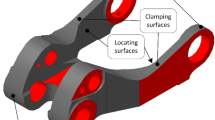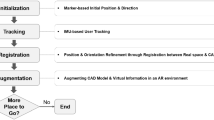Abstract
This study proposes an augmented reality (AR)-assisted workpiece-localization technique for rod-type flexible fixtures used in automotive and aerospace industries, for machining thin-walled components. The machining accuracy of a component depends considerably on the profile error and envelopment condition of the blank workpiece. An AR virtual reference of the component is created in the image space using a pinhole camera with a lens distortion model that visually assists the rough placement of the workpiece at the desired location. The fine workpiece-localization process is formulated as a nonlinear optimization problem to minimize the profile error. The problem is subjected to a point-in-polygon constraint in the image space to guarantee the envelopment requirement. The proposed method is validated using an aircraft body panel. It uses only the measurement data acquired from the upper surface of the panel and the AR reference and is a more flexible and accurate solution than the locating-pin method.
Similar content being viewed by others
References
L. Junbai and Z. Kai, Multi-point location theory, method, and application for flexible tooling system in aircraft manufacturing, The International Journal of Advanced Manufacturing Technology, 54(5–8) (2011) 729–736.
M. D. Do, Y. Son and H. J. Choi, Optimal workpiece positioning in flexible fixtures for thin-walled components, Computer-Aided Design, 95 (2018) 14–23.
H. T. Yau and C. H. Menq, A unified least-squares approach to the evaluation of geometric errors using discrete measurement data, International Journal of Machine Tools and Manufacture, 36(11) (1996) 1269–1290.
Y. X. Chu, J. B. Gou and Z. X. Li, On the hybrid localization/envelopment problem, The International Journal of Robotics Research, 18(5) (1999) 491–501.
Y. Sijie, Z. Yunfei, P. Fangyu and L. Xide, Research on the localisation of the workpieces with large sculptured surfaces in NC machin-ing, The International Journal of Advanced Manufacturing Technology, 23(5–6) (2004) 429–435.
L. Zhu, Z. Xiong, H. Ding and Y. Xiong, A distance function based approach for localization and profile error evaluation of complex surface, Journal of Manufacturing Science and Engineering, 126(3) (2004) 542–554.
Y. Dai, S. Chen, N. Kang and S. Li, Error calculation for corrective machining with allowance requirements, The International Journal of Advanced Manufacturing Technology, 49(5–8) (2010) 635–641.
Y. W. Sun, J. T. Xu, D. M. Guo and Z. Y. Jia, A unified localization approach for machining allowance optimization of complex curved surfaces, Precision Engineering, 33(4) (2009) 516–523.
G. Tan, L. Zhang, S. Liu and N. Ye, An unconstrained approach to blank localization with allowance assurance for machining complex parts, The International Journal of Advanced Manufacturing Technology, 73(5–8) (2014) 647–658.
G. He, M. Zhang and Z. Song, Error evaluation of free-form surface based on distance function of measured point to surface, Computer-Aided Design, 65 (2015) 11–17.
H. Gohari and A. Barari, A quick deviation zone fitting in coordinate metrology of NURBS surfaces using principle component analysis, Measurement, 92 (2016) 352–364.
A. Lang, Z. Song, G. He and Y. Sang, Profile error evaluation of free-form surface using sequential quadratic programming algorithm, Precision Engineering, 47 (2017) 344–352.
Y. Arezki, H. Nouira, N. Anwer and C. Mehdi-Souzani, A novel hybrid trust region minimax fitting algorithm for accurate dimensional metrology of aspherical shapes, Measurement, 127 (2018) 134–140.
N. Wan, P. Liu, Z. Chang and Z. C. Chen, The machining surface localization of free-form blade considering form tolerance, The International Journal of Advanced Manufacturing Technology, 95(9–12) (2018) 4469–4483.
Z. Chang, N. Wan, Z. C. Chen, R. Mo and D. Zhang, Part localization theory and its application on near-net-shape machining, The International Journal of Advanced Manufacturing Technology, 101(9–12) (2019) 2663–2679.
R. T. Azuma, A survey of augmented reality, Presence: Teleoperators & Virtual Environment, 6(4) (1997) 355–385.
J. Heikkila and O. Silven, A four-step camera calibration procedure with implicit image correction, Proc. of IEEE Computer Society Conference on Computer Vision and Pattern Recognition, San Juan, Puerto Rico (1997) 1106–1112.
Z. Zhang, Flexible camera calibration by viewing a plane from unknown orientations, Proc. of The Seventh IEEE International Conference on Computer Vision, Kerkyra, Greece (1999) 666–673.
Z. Zhang, A flexible new technique for camera calibration, IEEE Transactions on Pattern Analysis and Machine Intelligence, 22 (2000) 1330–1334.
L. Piegl and W. Tiller, The NURBS Book, Springer-Verlag, London, UK (1995).
K. Hormann and A. Agathos, The point in polygon problem for arbitrary polygons, Computational Geometry, 20(3) (2001) 131–144.
X. Hao, Y. Li, T. Deng, C. Liu and B. Xiang, Tool path transplantation method for adaptive machining of large-sized and thin-walled free form surface parts based on error distribution, Robotics and Computer-Integrated Manufacturing, 56 (2019) 222–232.
M. Ristic, I. Ainsworth and D. Brujic, Contact probe radius compensation using computer aided design models, Proc. of The Institution of Mechanical Engineers, Part B: Journal of Engineering Manufacture, 215(6) (2001) 819–834.
Acknowledgments
This work was supported by the Technology Innovation Program (10053248, Development of Manufacturing System for CFRP (Carbon Fiber Reinforced Plastics) Machining) funded by the Ministry of Trade, Industry & Energy (MOTIE, Korea). This research was also supported by the Chung-Ang University research grant in 2019.
Author information
Authors and Affiliations
Corresponding author
Additional information
Recommended by Editor Hyung Wook Park
Minh Duc Do is a graduate student at the School of Mechanical Engineering, Chung-Ang University (CAU), Seoul, Korea. He received his B.S. degree in Mechatronics Engineering from the Hanoi University of Science and Technology, Hanoi, Vietnam, in 2012. He completed his M.S. at the School of Mechanical Engineering, CAU, in 2016. His research interests include flexible fixtures, workpiece localization, design optimization, computer-aided design, and smart manufacturing.
Mingeon Kim is a graduate student at the School of Mechanical Engineering, Chung-Ang University, Seoul, Korea. He received his B.S. degree at the School of Mechanical Engineering, Kyungil University, in 2018. His research focuses on flexible fixtures, computer-aided design and manufacturing, and smart manufacturing.
Duy Hung Nguyen is a graduate student at the School of Mechanical Engineering, Chung-Ang University, Seoul, Korea. He received his B.S. degree in Mechatronics Engineering from the Hanoi University of Science and Technology, Hanoi, Vietnam, in 2012. His research focuses on flexible fixtures, workpiece localization, and smart manufacturing.
Hae-Jin Choi received his M.S. and Ph.D. degrees in Mechanical Engineering from the Georgia Institute of Technology (Georgia Tech), Atlanta, GA, USA, in 2001 and 2005, respectively. He was an Assistant Professor at the Nanyang Technological University, Singapore, and a Postdoctoral Fellow at the GWW School of Mechanical Engineering, Georgia Tech. He is currently a Professor at the School of Mechanical Engineering, Chung-Ang University, Seoul, Korea. His research interests include universal fixtures, simulation-based design optimization, management of uncertainty, and integrated materials and products design.
Rights and permissions
About this article
Cite this article
Do, M.D., Kim, M., Nguyen, D.H. et al. Augmented-reality-assisted workpiece localization in rod-type flexible fixtures. J Mech Sci Technol 34, 3007–3013 (2020). https://doi.org/10.1007/s12206-020-0632-3
Received:
Revised:
Accepted:
Published:
Issue Date:
DOI: https://doi.org/10.1007/s12206-020-0632-3




